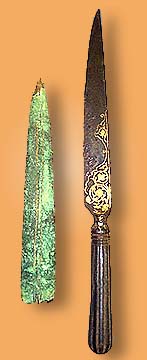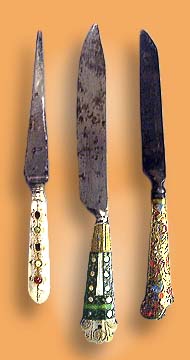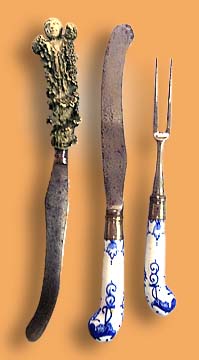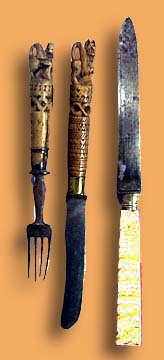

KNIVES
CAS 0389-1643A,B: 19th C. Italian or Spanish knife w/ sheath
 Knives
have been used as weapons, tools, and eating utensils since prehistoric times.
However, it is only in fairly recent times that knives have been designed specifically
for table use. Because hosts did not provide cutlery for their guests during
the Middle Ages in Europe, most people carried their own knives, similar to
the one at the left, in sheaths attached to their belts. These knives were narrow
and their sharply pointed ends were used to spear food and then raise it to
one's mouth.
Knives
have been used as weapons, tools, and eating utensils since prehistoric times.
However, it is only in fairly recent times that knives have been designed specifically
for table use. Because hosts did not provide cutlery for their guests during
the Middle Ages in Europe, most people carried their own knives, similar to
the one at the left, in sheaths attached to their belts. These knives were narrow
and their sharply pointed ends were used to spear food and then raise it to
one's mouth.
 Long
after knives were adopted for table use, however, they continued to be used
as weapons. Thus, the multi-purpose nature of the knife always posed the conceivable
threat of danger at the dinner table. However, once forks began to gain popular
acceptance, (forks being more efficient for spearing food), there was no longer
any need for a pointed tip at the end of a dinner knife. In 1669, King Louis
XIV of France decreed all pointed knives on the street or the dinner table illegal,
and he had all knife points ground down like those to the right in order to
reduce violence.
Long
after knives were adopted for table use, however, they continued to be used
as weapons. Thus, the multi-purpose nature of the knife always posed the conceivable
threat of danger at the dinner table. However, once forks began to gain popular
acceptance, (forks being more efficient for spearing food), there was no longer
any need for a pointed tip at the end of a dinner knife. In 1669, King Louis
XIV of France decreed all pointed knives on the street or the dinner table illegal,
and he had all knife points ground down like those to the right in order to
reduce violence.
CAS
0389-2106: 19th C. German (?) knife (left)
CAS 0389-1973: 18th C. German knife (center)
CAS 0389-1960: 18th C. (?) English (?) knife (right)
The grinding down
of knife points led to other design
changes.
Cutlers began to make the blunt ends of knives
wider and
rounder so that any food which fell between the
two tines
of a fork could be piled on the knife. In fact, many knives were designed with
a handle like a
 pistol
grip and a blade which curved backward so the wrist would not have to be contorted
to get food to the mouth as
can be seen to the left.
pistol
grip and a blade which curved backward so the wrist would not have to be contorted
to get food to the mouth as
can be seen to the left.
CAS 0389-1664:
18th C. English knife (left)
CAS 0389-1921 & 0389-1922: late 18th C.
English knife and fork set (right)
Interestingly,
this birth of blunt-tipped knives in Europe had a lasting effect on American
dining etiquette. At the beginning of the 18th Century, very few forks were
 being
imported to America. However, knives were being imported and their tips became
progressively blunter. Because Americans had very few forks and no longer had
sharp-tipped knives, they had to use spoons in lieu of forks. They would use
the spoon to steady food as they cut and then switch the spoon to the opposite
hand in order to scoop up food to eat. This distinctly American style of eating
continued even after
forks became
commonplace in the United States.
being
imported to America. However, knives were being imported and their tips became
progressively blunter. Because Americans had very few forks and no longer had
sharp-tipped knives, they had to use spoons in lieu of forks. They would use
the spoon to steady food as they cut and then switch the spoon to the opposite
hand in order to scoop up food to eat. This distinctly American style of eating
continued even after
forks became
commonplace in the United States.
By the beginning of the 19th Century, additional tines were being added to forks in Europe, and knives began to lose their curved, bulbous curved tips like those to the right.
CAS
0389-1610 & 0389-1990: late 19th
C.
Dutch or
German fork and knife set (left)
CAS 0389-1543: early 20th C. German knife (right)